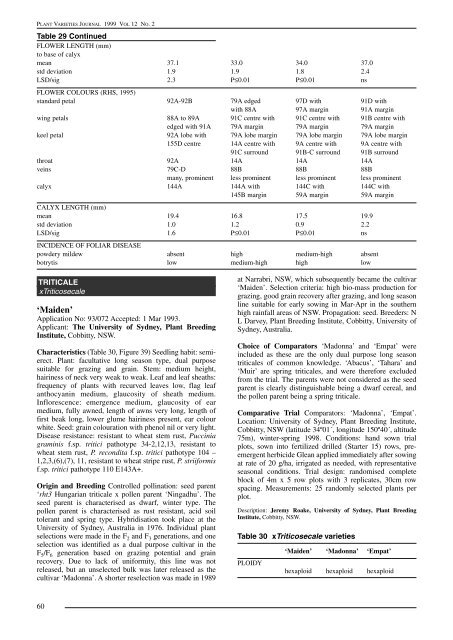56. Volume 12- Number 2 - IP Australia
56. Volume 12- Number 2 - IP Australia
56. Volume 12- Number 2 - IP Australia
Create successful ePaper yourself
Turn your PDF publications into a flip-book with our unique Google optimized e-Paper software.
PLANT VARIETIES JOURNAL 1999 VOL <strong>12</strong> NO. 2<br />
Table 29 Continued<br />
FLOWER LENGTH (mm)<br />
to base of calyx<br />
mean 37.1 33.0 34.0 37.0<br />
std deviation 1.9 1.9 1.8 2.4<br />
LSD/sig 2.3 P≤0.01 P≤0.01 ns<br />
FLOWER COLOURS (RHS, 1995)<br />
standard petal 92A-92B 79A edged 97D with 91D with<br />
with 88A 97A margin 91A margin<br />
wing petals 88A to 89A 91C centre with 91C centre with 91B centre with<br />
edged with 91A 79A margin 79A margin 79A margin<br />
keel petal 92A lobe with 79A lobe margin 79A lobe margin 79A lobe margin<br />
155D centre 14A centre with 9A centre with 9A centre with<br />
91C surround 91B-C surround 91B surround<br />
throat 92A 14A 14A 14A<br />
veins 79C-D 88B 88B 88B<br />
many, prominent less prominent less prominent less prominent<br />
calyx 144A 144A with 144C with 144C with<br />
145B margin 59A margin 59A margin<br />
CALYX LENGTH (mm)<br />
mean 19.4 16.8 17.5 19.9<br />
std deviation 1.0 1.2 0.9 2.2<br />
LSD/sig 1.6 P≤0.01 P≤0.01 ns<br />
INCIDENCE OF FOLIAR DISEASE<br />
powdery mildew absent high medium-high absent<br />
botrytis low medium-high high low<br />
TRITICALE<br />
xTriticosecale<br />
‘Maiden’<br />
Application No: 93/072 Accepted: 1 Mar 1993.<br />
Applicant: The University of Sydney, Plant Breeding<br />
Institute, Cobbitty, NSW.<br />
Characteristics (Table 30, Figure 39) Seedling habit: semierect.<br />
Plant: facultative long season type, dual purpose<br />
suitable for grazing and grain. Stem: medium height,<br />
hairiness of neck very weak to weak. Leaf and leaf sheaths:<br />
frequency of plants with recurved leaves low, flag leaf<br />
anthocyanin medium, glaucosity of sheath medium.<br />
Inflorescence: emergence medium, glaucosity of ear<br />
medium, fully awned, length of awns very long, length of<br />
first beak long, lower glume hairiness present, ear colour<br />
white. Seed: grain colouration with phenol nil or very light.<br />
Disease resistance: resistant to wheat stem rust, Puccinia<br />
graminis f.sp. tritici pathotype 34-2,<strong>12</strong>,13, resistant to<br />
wheat stem rust, P. recondita f.sp. tritici pathotype 104 –<br />
1,2,3,(6),(7), 11, resistant to wheat stripe rust, P. striiformis<br />
f.sp. tritici pathotype 110 E143A+.<br />
Origin and Breeding Controlled pollination: seed parent<br />
‘rht3 Hungarian triticale x pollen parent ‘Ningadhu’. The<br />
seed parent is characterised as dwarf, winter type. The<br />
pollen parent is characterised as rust resistant, acid soil<br />
tolerant and spring type. Hybridisation took place at the<br />
University of Sydney, <strong>Australia</strong> in 1976. Individual plant<br />
selections were made in the F 2 and F 3 generations, and one<br />
selection was identified as a dual purpose cultivar in the<br />
F 5 /F 6 generation based on grazing potential and grain<br />
recovery. Due to lack of uniformity, this line was not<br />
released, but an unselected bulk was later released as the<br />
cultivar ‘Madonna’. A shorter reselection was made in 1989<br />
at Narrabri, NSW, which subsequently became the cultivar<br />
‘Maiden’. Selection criteria: high bio-mass production for<br />
grazing, good grain recovery after grazing, and long season<br />
line suitable for early sowing in Mar-Apr in the southern<br />
high rainfall areas of NSW. Propagation: seed. Breeders: N<br />
L Darvey, Plant Breeding Institute, Cobbitty, University of<br />
Sydney, <strong>Australia</strong>.<br />
Choice of Comparators ‘Madonna’ and ‘Empat’ were<br />
included as these are the only dual purpose long season<br />
triticales of common knowledge. ‘Abacus’, ‘Tahara’ and<br />
‘Muir’ are spring triticales, and were therefore excluded<br />
from the trial. The parents were not considered as the seed<br />
parent is clearly distinguishable being a dwarf cereal, and<br />
the pollen parent being a spring triticale.<br />
Comparative Trial Comparators: ‘Madonna’, ‘Empat’.<br />
Location: University of Sydney, Plant Breeding Institute,<br />
Cobbitty, NSW (latitude 34º01´, longitude 150º40´, altitude<br />
75m), winter-spring 1998. Conditions: hand sown trial<br />
plots, sown into fertilized drilled (Starter 15) rows, preemergent<br />
herbicide Glean applied immediately after sowing<br />
at rate of 20 g/ha, irrigated as needed, with representative<br />
seasonal conditions. Trial design: randomised complete<br />
block of 4m x 5 row plots with 3 replicates, 30cm row<br />
spacing. Measurements: 25 randomly selected plants per<br />
plot.<br />
Description: Jeremy Roake, University of Sydney, Plant Breeding<br />
Institute, Cobbitty, NSW.<br />
Table 30 xTriticosecale varieties<br />
PLOIDY<br />
‘Maiden’ ‘Madonna’ ‘Empat’<br />
hexaploid hexaploid hexaploid<br />
60

















